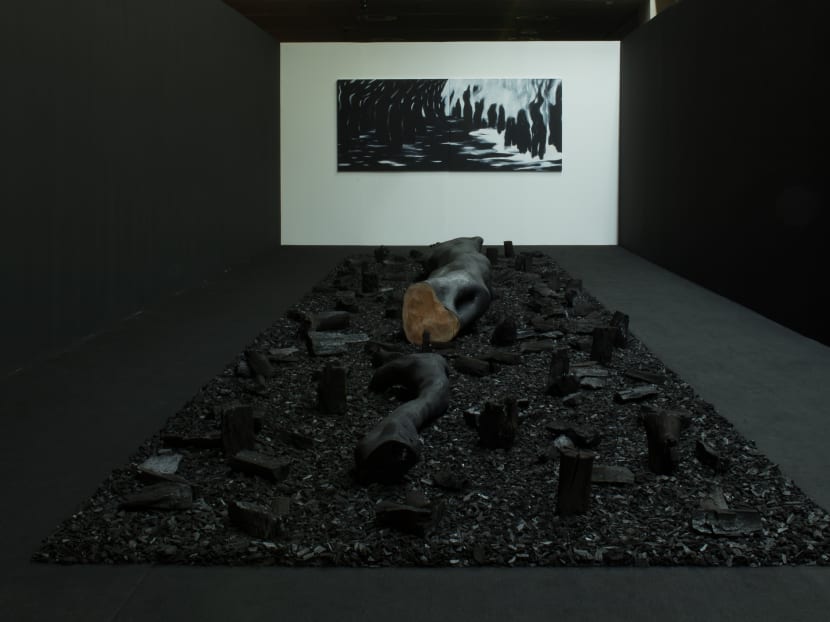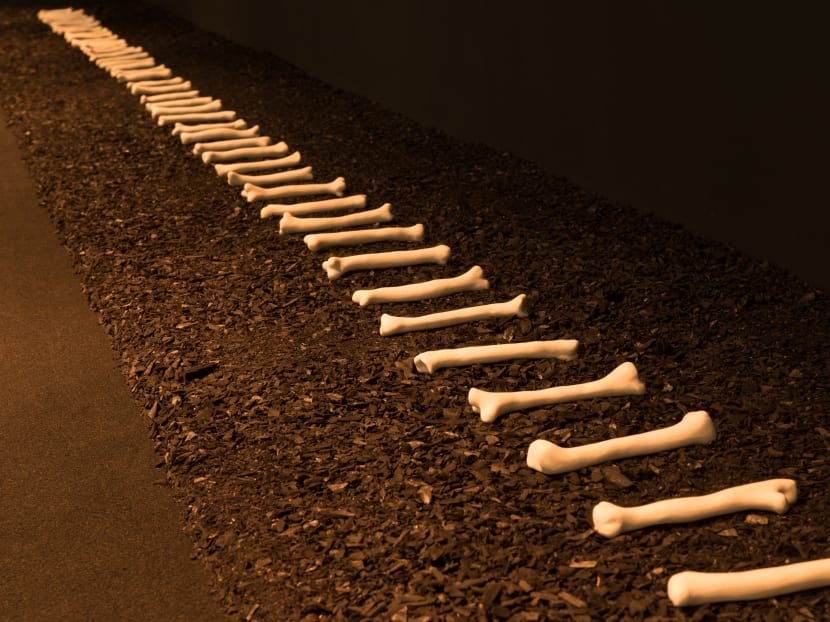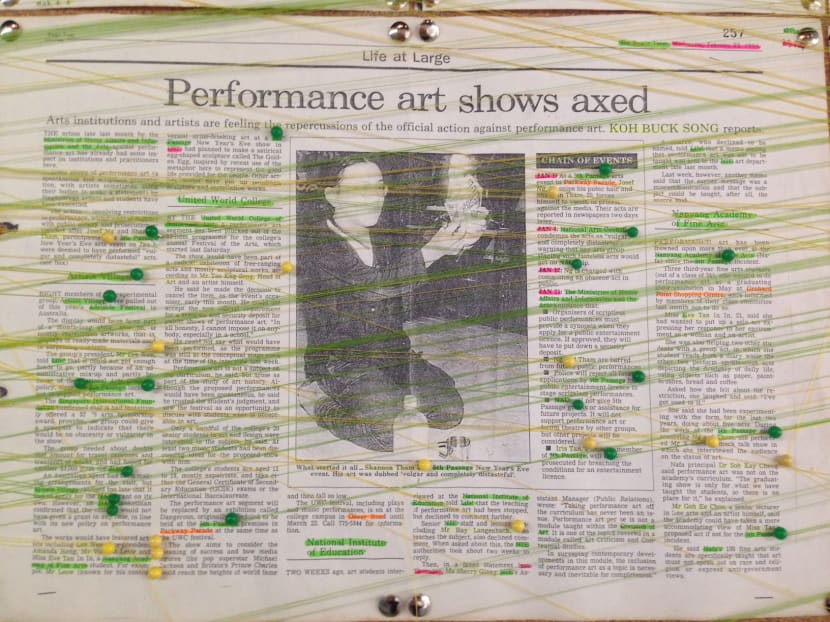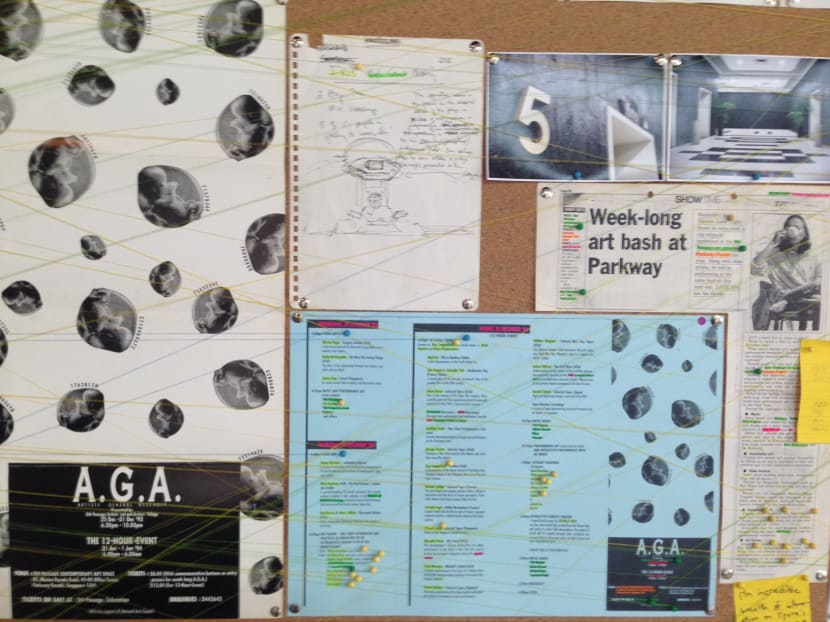Visit Han Sai Por’s Black Forest, encounter Sculpture Square’s Ghost
SINGAPORE — The centrepiece in Han Sai Por’s ongoing exhibition Black Forest 2013 is quite arresting. You’ve got an installation comprising two charcoal logs on a bed of charcoal. One of these looks like a huge bone, the other revealing the slightest hint of brown, life peeking from the charred remains. It’s a warning about the dangers of environmental destruction via deforestation.




SINGAPORE — The centrepiece in Han Sai Por’s ongoing exhibition Black Forest 2013 is quite arresting. You’ve got an installation comprising two charcoal logs on a bed of charcoal. One of these looks like a huge bone, the other revealing the slightest hint of brown, life peeking from the charred remains. It’s a warning about the dangers of environmental destruction via deforestation.
While it’s a continuation of the Cultural Medallion recipient’s 2011 show at the Esplanade, the Sumatran haze incident this year also gives it a sense of timeliness and urgency.
Around it are other sculptural and installation pieces that reinforce Han’s message in a forceful and visceral manner: “Bones” laid out on a bed of charcoal, tree branches and stumps (although the inclusion of sad background music over a rather moralising video in one of the pieces seems, to me, a bit of an overkill in an already impactful set of works — strongly felt as a kind of silent aftermath of destruction in this already darkened venue space.)
You’ve also got other series on display at Black Forest 2013. Drawings of abstracted and figurative shapes of tree branches, her familiar sculptures of seeds and seashells. You see these first upon entering gallery before finally coming across those wonderful, foreboding installations I mentioned earlier.
Which, perhaps, would be the only main misgiving I have with how the whole show is laid out.
Because there are actually, to my mind, two (linked) things being said here. There’s an interesting argument here about the potentially flawed idea of reforestation by way of genetically modified plants. One destroys nature and replaces it with another kind of nature that’s actually unnatural. And that this might do more harm than good. Some of the sculptures of “genetic plants”, for instance, look nothing like plants.
It’s this extended statement that theoretically pushes Black Forest 2013 beyond its aesthetically solid-but-we-kinda-already-know-that environmental plea — the unnatural, rarely-discussed impact of potentially wayward efforts of science after man/industry ravages its surroundings. While the charcoal installations are the visual highlights of the show, I thought this was the most interesting point discourse-wise. Unfortunately, with the way it’s all been laid out, these strange plants get somehow overshadowed by the former’s (arguable deserved) position as sentimental spectacle at the latter half of the venue.
Yeah, I sound like I’m nitpicking over what’s a pretty good show. So why not do it again for another good show? Woot.
***
Next door at Sculpture Square is the group show Ghost.
It took while to drop by once more for a proper look but I think it warrants a shout out before the show wraps up at the end of the month.
Subtitled “The Body At The Turn Of The Century”, it’s another laudable show that turns the notion of the venue as place for “sculpture” on its head. Folks from the fields of theatre, music and film join visual artists in exploring issues regarding the “body”, touching on the female body and the punk scene, for instance.
And then there’s Loo Zihan’s excellent documentary installation on the Artists’ General Assembly.
Correct me if I’m wrong but to my knowledge, this has been the only public artistic response done for the 20th anniversary of the single most important/notorious/pivotal moment in Singapore’s contemporary art history. You know, the week-long event organised by 5th Passage and The Artists Village at the end of December 1993. The one where Josef Ng performed Brother Cane. Where a sensationalist media report would eventually traumatise what was then a burgeoning performance art scene.
Or is the anniversary next year?
Anyways, while I do like Ghost, I also think Zihan’s piece (which is essentially an installation of Ray Langenbach’s archive) is important enough to have gotten its own show (although there’s one piece in Ghost, by Lee Wen and Koh Nguang How, that references and looks back at AGA as well).
Here you have videos, and on the two facing walls lots and lots and lots of documents regarding the AGA and the following year’s other “scandal” on forum theatre and The Necessary Stage: News reports, commentaries, correspondences, legal documents, names, names, names. Zihan then uses thread to link all these information together.
It’s systematically presented but at the same time, also kind of chaotic. It gives us a whole lot of information but it also imparts a confusion of voices.
It’s not exactly about “reliving” or re-presenting that moment, or a kind of messy library archive — its presentation (and our varying degrees of success in navigating it) is equally important. The bad quality of videos, skipping, fuzzy, aren’t just technical glitches but perhaps, poetically speaking, snatches of erasure. The threads, too, while functioning as links, often obfuscates the very documents they draw attention to.
You should spend some time on this work. There are some broad realisations (and for people like me who weren’t there two decades ago, discoveries) here: That AGA wasn’t just about performance art; it had theatre, literature, forum discussions, punk music. That, if you go by the web of links Zihan has created, TAV seemed to be in the thick of things (or at least the artists everywhere and on everyone’s lips) and 5th Passage not really (despite it being their space and having done a similar event the year before).
Finally, it’s a living, interactive work. Scattered throughout are post-its by gallery visitors (and a cigarette cheekily tacked under Ng’s name).
“An incredible wealth of information on S’pore’s performance art and regulatory history,” says one. It’s a rather telling comment and quite true, as the second bit is as much on display here as art itself.
The show ends on Dec 31. Wouldn’t it be cool to actually echo the AGA event and have it open until the next day?
Black Forest runs until Jan 12, 11am to 7pm, NAFA Galleries 1 & 2. Closed on Mondays and public holidays. Ghost: The Body At The Turn Of The Century runs until Dec 31, 11am to 7pm, Sculpture Square. Free admission for both.








